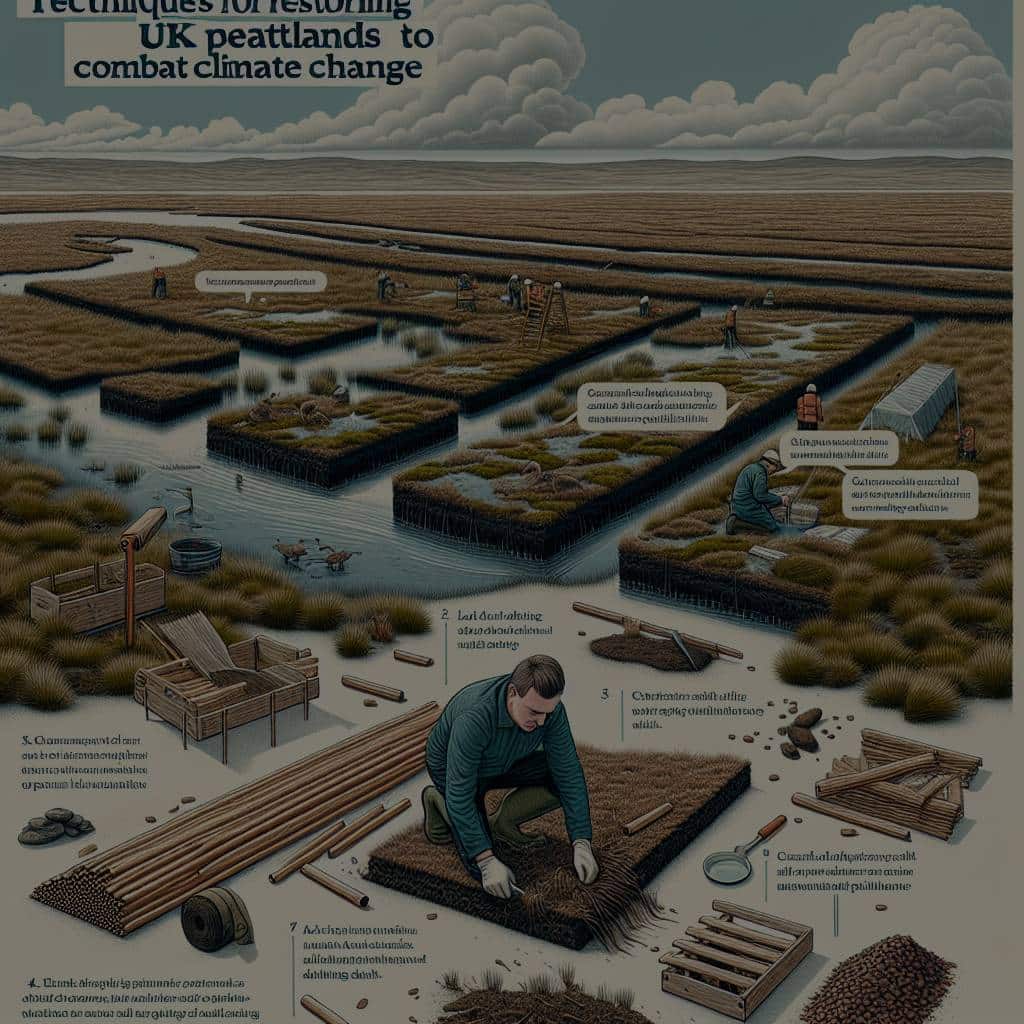What Are the Techniques for Restoring UK Peatlands to Combat Climate Change?

Peatlands in the UK are a vital part of our environment, playing a crucial role in supporting biodiversity, storing carbon, and regulating water cycles. However, many of these ecologically important areas are now degraded due to various anthropogenic activities. This degradation has led to a massive loss of biodiversity, increased carbon emissions, and altered water cycles. That is where the urgent need for peatland restoration comes in. The restoration of these vital ecosystems will ensure the mitigation of climate change effects, boosting of biodiversity, improved water regulation, and the return of lost species.
The Importance of Peatlands in Climate Change Mitigation
Before delving into the specifics of how the UK is restoring its peatlands, it’s essential to understand the critical role these ecosystems play in mitigating climate change. Peatlands are a type of wetland, covered in waterlogged organic soil known as peat. This wet, oxygen-deprived environment is the perfect place for carbon capture and storage.
In the same genre : How Can Digital Twins Technology Enhance the Performance of UK Wind Farms?
As the plants in peatlands die, they don’t fully decompose due to the lack of oxygen. This means that carbon, which would ordinarily be released back into the atmosphere, remains trapped in the peat soil. This makes peatlands incredibly efficient carbon sinks.
However, when peatlands are degraded or drained for agriculture, forestry, and peat extraction, this stored carbon is released back into the atmosphere in the form of greenhouse gases. This not only contributes to climate change but also threatens the biodiversity of these unique ecosystems.
Additional reading : What Are the Best Practices for Designing Accessible Websites for the Visually Impaired?
The National Approach to Peatland Restoration
In response to the climate change crisis and the degradation of peatlands, the UK has initiated a national approach to restore these vital areas. The Peatland Code, a voluntary standard for UK peatland projects, has been instrumental in driving this change. This standard provides guidelines for monitoring the progress of peatland restoration projects and guarantees their outcomes, including carbon storage and biodiversity enhancement.
The methodology of the Peatland Code involves rewetting the peatland, reintroducing native vegetation, and managing the land to prevent further degradation. These projects aim to restore peatlands’ functionality as carbon sinks and habitats for numerous species.
Techniques for Restoring UK Peatlands
Various Techniques are employed to restore peatlands in the UK. One of the most common methods is rewetting, which involves blocking drains and ditches that were previously dug to dry out the peatland for agricultural use. This process allows the peat soil to become waterlogged again, creating the ideal conditions for peat formation and carbon storage.
Another common method is the reintroduction of native vegetation, which can include mosses, sedges, and other peatland plants. These species play a crucial role in peat formation and provide habitats for numerous animal species, thus restoring biodiversity.
Lastly, land management practices, such as reducing grazing intensity or ceasing peat extraction, are integral to the restoration process. These practices can help to prevent further degradation and ensure that the restored peatland remains a functioning ecosystem.
The Future of Peatland Restoration
While significant progress has been made, a considerable amount of work needs to be done to restore all degraded peatlands in the UK. This will require continued investment in restoration projects and research into more effective restoration techniques.
The UK government has recognized the importance of peatland restoration in its 25 Year Environment Plan. It has committed to restoring 64,000 hectares of peatland by 2025. This target will significantly contribute to the UK’s commitment to achieving net-zero carbon emissions by 2050.
The Role of Individuals and Communities in Peatland Restoration
While government initiatives and projects play a crucial role in peatland restoration, individuals and communities also have a part to play. Educating oneself about the importance of peatlands and the threats they face is a good starting point. Understanding the role of peatlands in mitigating climate change can help individuals make informed decisions about their actions and their impact on these ecosystems.
Communities can also get involved in local peatland restoration projects, either by volunteering their time or donating to organizations that carry out these projects. By taking part in these restoration efforts, individuals and communities can help protect these vital ecosystems and fight against climate change.
Peatlands are an invaluable asset in our fight against climate change. The restoration of these vital ecosystems will ensure the mitigation of climate change effects, boosting of biodiversity, improved water regulation, and the return of lost species. The entire process seems like a daunting task, but through national efforts, innovative restoration techniques, and community involvement, the tide can be turned.
Advancements in Restoration Techniques and Research
Peatland restoration has seen significant advancements in the UK, with new techniques and scientific research supporting the fight against climate change. These advancements are crucial as they help ensure the efficiency of restoration projects and the longevity of the restored peatlands.
Rewetting, for instance, has been improved by using more accurate mapping and water level monitoring. This enhances the effectiveness of the process, ensuring that the peatland is adequately waterlogged for optimum carbon storage.
Vegetation reintroduction has also been improved through scientific research. Scientists have identified the best species to reintroduce based on their ability to aid peat formation and provide habitats for local wildlife. This has led to increased biodiversity in restored peatlands, aiding in the fight against species extinction.
Moreover, research into peatland ecosystems has given us a better understanding of the dynamics between peatland health and climate change. This knowledge is crucial as it helps guide restoration efforts, ensuring they are tailored to maximise their impact on combatting climate change.
Peat extraction, a significant contributor to peatland degradation, has also been addressed. New legislation has been introduced to limit peat extraction, and environmental agencies are working closely with peatland businesses to promote sustainable practices. This collaborative approach will ensure the longevity of peatland restoration efforts.
Achievements and Future Goals in Peatland Restoration
Through relentless efforts in peatland restoration, the UK has made significant strides in mitigating climate change and enhancing biodiversity. The success of the Peatland Code and the achievements of numerous restoration projects attest to the country’s commitment to protect these vital ecosystems.
However, there is still an uphill task ahead. The UK government’s commitment to restoring 64,000 hectares of peatland by 2025 is a massive step, but the work doesn’t stop there. The climate crisis requires continuous action, and peatland restoration will remain a priority in the fight against climate change.
Looking ahead, the goal is to implement more efficient restoration techniques and support the research that drives these advancements. The United Nations has highlighted peatlands as a significant factor in climate change mitigation, and the UK is taking steps to meet this global challenge.
Individuals and communities also have a role to play. With increased awareness and involvement in peatland restoration projects, every citizen can contribute to the fight against climate change. Whether it’s volunteering in a local peatland project or making lifestyle choices that reduce carbon emissions, every effort counts.
In conclusion, peatland restoration in the UK is more than a national project; it’s a global fight against climate change. Through government initiatives, scientific advancements, and community involvement, the UK is striving to protect its peatlands and, in turn, our planet. The challenge is considerable, but with continued dedication and effort, the tide of climate crisis can be turned.
